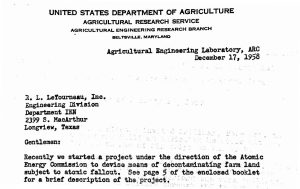Another DIve Into the Archives
by admin | July 12, 2019 7:15 am
As the summer sun beats down outside, I am spending a fair amount of time comfortably tucked inside the Estes Library, getting paid to go through boxes of documents contained in the R.G. LeTourneau Industries archives. Four of us are working to put at least some of the boxes into some sensible order, as I have mentioned before. This is a long-term project.
Here are some interesting pieces I have found over the past several weeks:
• One file folder contained a series of letters between the company and the United States Department of Agriculture. In December 1958, a research agricultural engineer wrote to the company: Recently we started a project under the direction of the Atomic Energy Commission to devise means of decontaminating farm land subject to atomic fallout… Up to now, we have used equipment commonly found on farms and that used in road maintenance equipment.

The letter concludes the area of contaminated soil due to atomic fallout could be 120 miles long and 30 miles wide. LeTourneau Industries, a pioneer in building massive earthmoving equipment, was asked to provide technical knowledge of what type of equipment could handle this task.
This was during the midst of the Cold War, just a few years before the Cuban missile crisis nearly plunged us into nuclear war. Schoolchildren in America, including me a few years later, were being taught how to cower under our desks in the event of a nuclear attack. Even as a child, the notion that my puny desk would save me from atomic fallout seemed ludicrous.
As it turned out, the agriculture department was just seeking advice, and nothing ever came of this rather frightening – and far-fetched — notion.
• Another packet of folders was filled with marketing materials: advertisements that appeared in Business Week and Forbes to plug the many different types of massive equipment that LeTourneau Industries manufactured and sold, such as the Sno-Train. It was described as an over-sized tractor trailer that could travel over almost any type of terrain. The Sno-Train had 16, 10-foot tires, was a city block long and could carry up to 100,000 pounds of military supplies above the Arctic Circle. The Army bought one, according to a press release in the files.
Those files, from the late 1950s, also contained Shibboleths of the “Acceptable” Copy Writers. Those were the folks creating the advertisements and press releases to promote the products. A dozen copy commandments were included, with at least eight to be used “in every copy unit.” Here are a few examples:
Introduce every statement that supports a fact with HERE’S WHY:
Use liberally the adjectives BIG and EXTRA.
Conditions under which the product functions must always be either TOUGH or RUGGED.
All human actions necessary to the use of the product must be described as SIMPLE.
Copy writers also were given lists of adjectives and nouns that could be used in creating advertisements. Some of the adjectives included able, agile, iron-muscled, nimble, and scrappy. Suggested nouns included behemoth, dirtmover, juggernaut, ground gobbler, and marvel.
Indeed, these were truly marvelous machines worthy of the suggested adjectives and nouns.
• Company founder R.G. LeTourneau received tons of correspondence. One piece came from a 9-year-old boy living in Dallas. He sketched out a design for an underground stadium, and suggested LeTourneau’s earthmoving equipment could be used to build it. The boy’s proud mother sent it along, and somehow it ended up in the company’s files.
The lad was clearly ahead of his time, wanting to be able to watch sporting events in the summer without broiling his head. Rather than dig down, a few years later Roy Hofheinz spearheaded the building of the Astrodome in Houston – the first domed stadium.
•Finally, a 1959 memo announced the Service Department was responsible for all mimeographing done at the plant. I can still conjure up the smell of a mimeograph machine, cranking out purple-type copies from a stencil typed on a manual typewriter.
Not that I miss it.
Source URL: https://garyborders.com/pages/another-dive-into-the-archives/